Effects of Variety and Sett Weights on Sprout Emergence and Seed Tuber Yield in Dioscorea alata L. and Dioscorea rotundata Poir.
Abstract
1. Introduction
2. Materials and Methods
2.1. Study Location
2.2. Preparation of Experimental Materials
2.3. Field Establishment and Experimental Layout
2.4. Agronomic Operations
2.5. Data Collection
- i.
- Number of stands harvested: The total number of plant stands per variety with yam tubers at harvest.
- ii.
- Tuber count at harvest: Total number of tubers harvested per plant in a plot at harvest.
- iii.
- Weight of tubers at harvest: The measured weight of the tubers harvested per variety per plot at harvest (measured in g).
2.6. Statistical Analysis
3. Results
3.1. Plant Stand
3.2. Yield at Harvest
3.3. Seed Categories
3.4. Relationships Between the Growth and Yield Parameters
4. Discussion
5. Conclusions
Future Perspective
Author Contributions
Funding
Data Availability Statement
Acknowledgments
Conflicts of Interest
Abbreviations
| AYMT | Adapted yam minisett technology |
| SYT | Seed yam tubers |
| MAP | Months after planting |
| YMT | Yam minisett technology |
| SW | Set weight |
| IITA | International Institute of Tropical Agriculture |
| STH | Seed tubers harvested |
| STHHTLC | Proportion of seed tubers heavier than seed category |
| STHLTSC | Proportion of seed tubers lighter than seed category |
References
- Akinola, A.A.; Ezeorah, S.N.; Nwoko, E.P. Modelling the rehydration characteristics of White Yam. West Indian J. Eng. 2019, 2, 70–76. [Google Scholar]
- Mignouna, D.B.; Akinola, A.A.; Abdoulaye, T.; Alene, A.D.; Manyong, V.; Maroya, N.G.; Aighewi, B.A.; Kumar, L.P.; Balogun, M.; Lopez-Montes, A.; et al. Potential returns to yam research investment in sub-Saharan Africa and beyond. Outlook Agric. 2020, 49, 215–224. [Google Scholar] [CrossRef] [PubMed]
- Obidiegwu, J.E.; Lyons, J.B.; Chilaka, A.C. The Dioscorea Genus (Yam)—An appraisal of nutritional and therapeutic potentials. Foods 2020, 9, 1304. [Google Scholar] [CrossRef] [PubMed]
- Ossai, C.O.; Morufat, O.B.; Norbert, G.M. Organogenesis versus somatic embryogenesis pathway efficiencies in in vitro propagation of white and water yams. In Vitro Cellular and Developmental Biology-Plant; Springer: Berlin/Heidelberg, Germany, 2023. [Google Scholar] [CrossRef]
- Ossai, C.O.; Balogun, M.; Maroya, N. Status and prospects of yam somatic embryogenesis: A pathway for biotechnology applications. In Vitro Cellular and Developmental Biology-Plant; Springer: Berlin/Heidelberg, Germany, 2024. [Google Scholar] [CrossRef]
- Nweke, F.I.; Okoroji, E.C.; Njoku, J.E.; Kling, D.J. Expenditure elasticity of demand for major food items in Southeast Nigeria. Trop. Agric. 1994, 71, 229–234. [Google Scholar]
- Palemo, O.; de Koeyer, D.; Matsumoto, R.; Agre, P.; Asiedu, R.; Asfaw, A. Semi-Autotrophic Hydroponics: A Robust Technique for Accelerated Basic Seed Yam Production; International Institute of Tropical Agriculture: Ibadan, Nigeria, 2018; 1p. [Google Scholar]
- Aighewi, B.A.; Maroya, N.; Asiedu, R.; Aihebhoria, D.; Balogun, M.; Mignouna, D. Seed yam production from whole tubers versus minisetts. J. Crop Improv. 2020, 34, 858–874. [Google Scholar] [CrossRef]
- Okoli, O.O.; Akoroda, M.O. Providing seed tubers for the production of food yams. Afr. J. Root Tuber Crops 1995, 1, 1–6. [Google Scholar]
- Aighewi, B.A.; Asiedu, R.; Maroya, N.; Balogun, M. Improved propagation methods to raise the productivity of Yam (Dioscorea rotundata Poir.). Food Secur. 2015, 7, 823–834. [Google Scholar] [CrossRef]
- Osei-Adu, J.; Aidoo, R.; Simon Cudjoe Fialor, S.C.; Ennin, S.A.; Osei, K.; Owusu, B.A. Profitability of positive selection technique for seed yam production in Ghana and Nigeria. Cogent Econ. Financ. 2022, 10, 2034281. [Google Scholar] [CrossRef]
- Lebot, V. Tropical Root and Tuber Crops: Cassava, Sweet Potato, Yams and Aroids. In Crop Production Science in Horticulture No. 17; CABI Publishing: Wallingford UK, 2009; 413p. [Google Scholar]
- Asiedu, R. Yams production in West Africa and collaborative research. Agron. Afr. Numero Spec. 2003, 4, 173–176. [Google Scholar]
- Okoro, J.K. Awareness and Use of the Rapid Seed–yam Multiplication Technology by Farmers in Nigeria’s Yam Belt. Prod. Agric. Technol. J. 2008, 5, 22–29. [Google Scholar]
- Oguntade, A.E.; Thompson, O.A.; Ige, T. Economics of Seed Yam Production using Minisett Technique in Oyo State, Nigeria. Field Actions Sci. Rep. 2010, 4, 98–105. [Google Scholar]
- Ayankanmi, T.; Shiwachi, H.; Asiedu, R. Sprouting and yield of yam (Dioscorea spp.) minisetts in relation to sett size, soil moisture, and agroecology. Trop. Sci. 2006, 45, 23–27. [Google Scholar] [CrossRef]
- McNamara, N.; Morse, S. Working with farmers to produce clean seed yam. In Yam Improvement for Income and Food Security in West Africa; YIIFSWA working Paper Series No. 5; International Institute of Tropical Agriculture: Ibadan, Nigeria, 2014; p. 48. [Google Scholar]
- Emokaro, C.O.; Law-Ogbomo, K.E. The influence of minisett size on the profitability of yam production in Edo State, Nigeria. Res. J. Agric. Biol. Sci. 2008, 4, 672–675. [Google Scholar]
- IITA. IITA Agro-Climatology, 2013–2014 Report; IITA: Ibadan, Nigeria, 2015. [Google Scholar]
- Darkwa, K.; Olasanmi, B.; Asiedu, R.; Asfaw, A. Review of empirical and emerging breeding methods and tools for yam (Dioscorea spp.) improvement: Status and prospects. Plant Breed. 2020, 3, 474–497. [Google Scholar] [CrossRef]
- Alieu, S.; Asiedu, R.; Jorge, F. Genetic and phenotypic diversity in a germplasm working collection of cultivated tropical yams (Dioscorea spp.). Genet. Resour. Crop Evol. 2012, 59, 1753–1765. [Google Scholar]
- Akoroda, M.O.; Claudius–Cole, B.; Ojuyawo, H.; Okonkwo, C.C.; Aighewi, B.A.; Acha, A.I.; Asiedu, R. Enhancing seed yam supply system in West Africa: Root and tuber crop for poverty alleviation through science and technique for sustainable development. In Proceedings of the 10th ISTRC–AB Symposium, Maputo, Mozambique, 8−12 October 2007; Mahungu, N.M., Ed.; IIAM: Ibadan, Nigeria; pp. 122–135. [Google Scholar]
- Aighewi, B.A.; Akoroda, M.O.; Asiedu, R. Seed–yam (Dioscorea rotundata Poir) production, storage, and quality in selected yam zone Nigeria. Afr. J. Root Tuber Crops 2003, 5, 20–23. [Google Scholar]
- Balogun, M.O.; Maroya, N.; Asiedu, R. Status and prospects for improving yam seed systems using temporary immersion bioreactors. Acad. J. 2014, 13, 1614–1622. [Google Scholar]
- Iseki, K.; Matsumoto, R. Effect of Seed Sett Size on Sprouting, Shoot Growth, and Tuber Yield of White Guinea Yam (Dioscorea rotundata). Plant Prod. Sci. 2019, 23, 75–80. [Google Scholar] [CrossRef]
- Sobulo, R.A. Studies on white yam (Dioscorea rotundata) Growth analysis. Exp. Agric. 1972, 8, 99–106. [Google Scholar] [CrossRef]
- Coyne, D.L.; Claudius-Cole, A.O.; Kenyon, L.; Baimey, H. Differential effect of hot water treatment on whole tubers versus cut setts of yam (Dioscorea spp.). Pest Manag. Sci. 2009, 10, 81–87. [Google Scholar] [CrossRef] [PubMed]
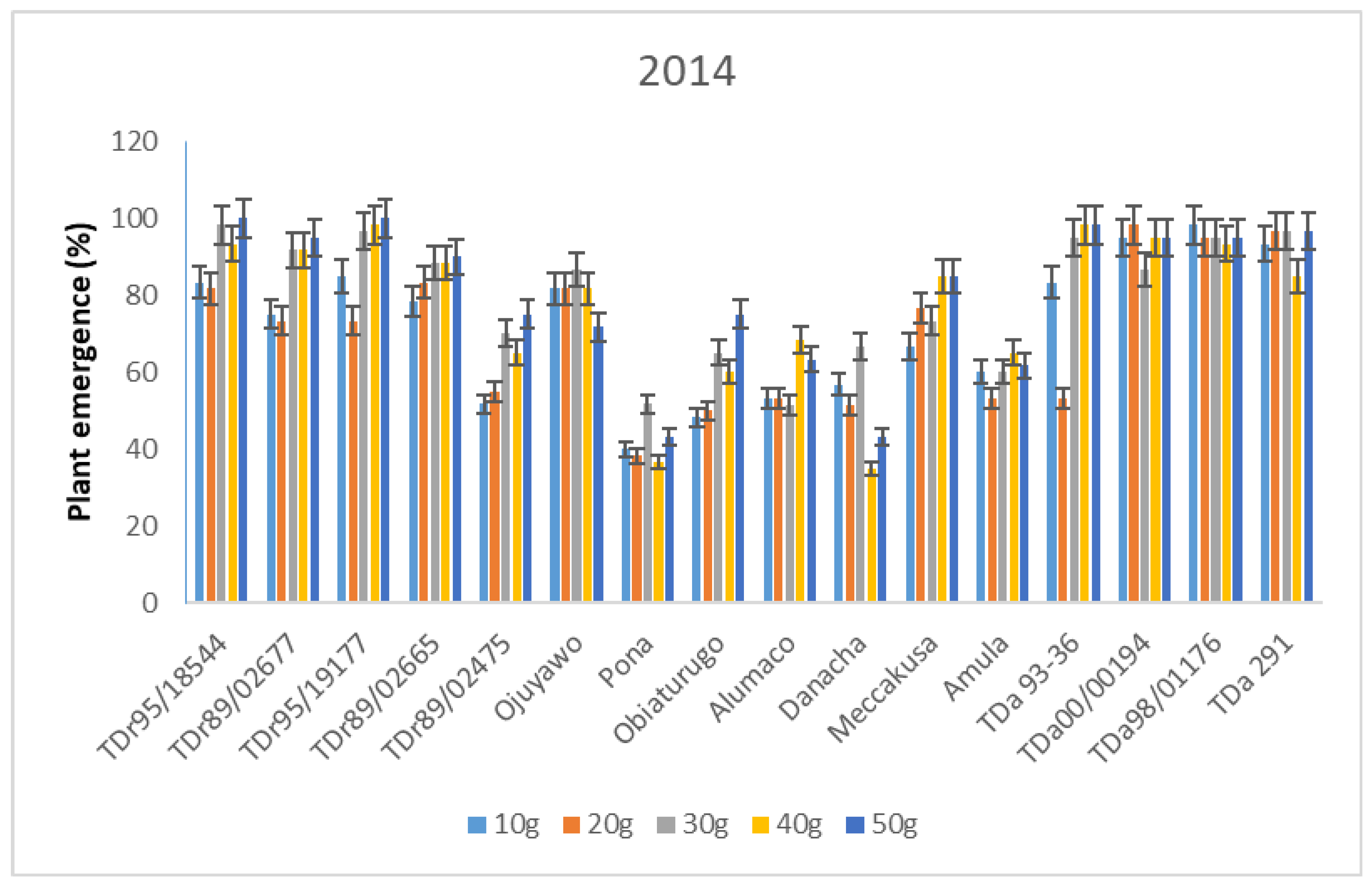
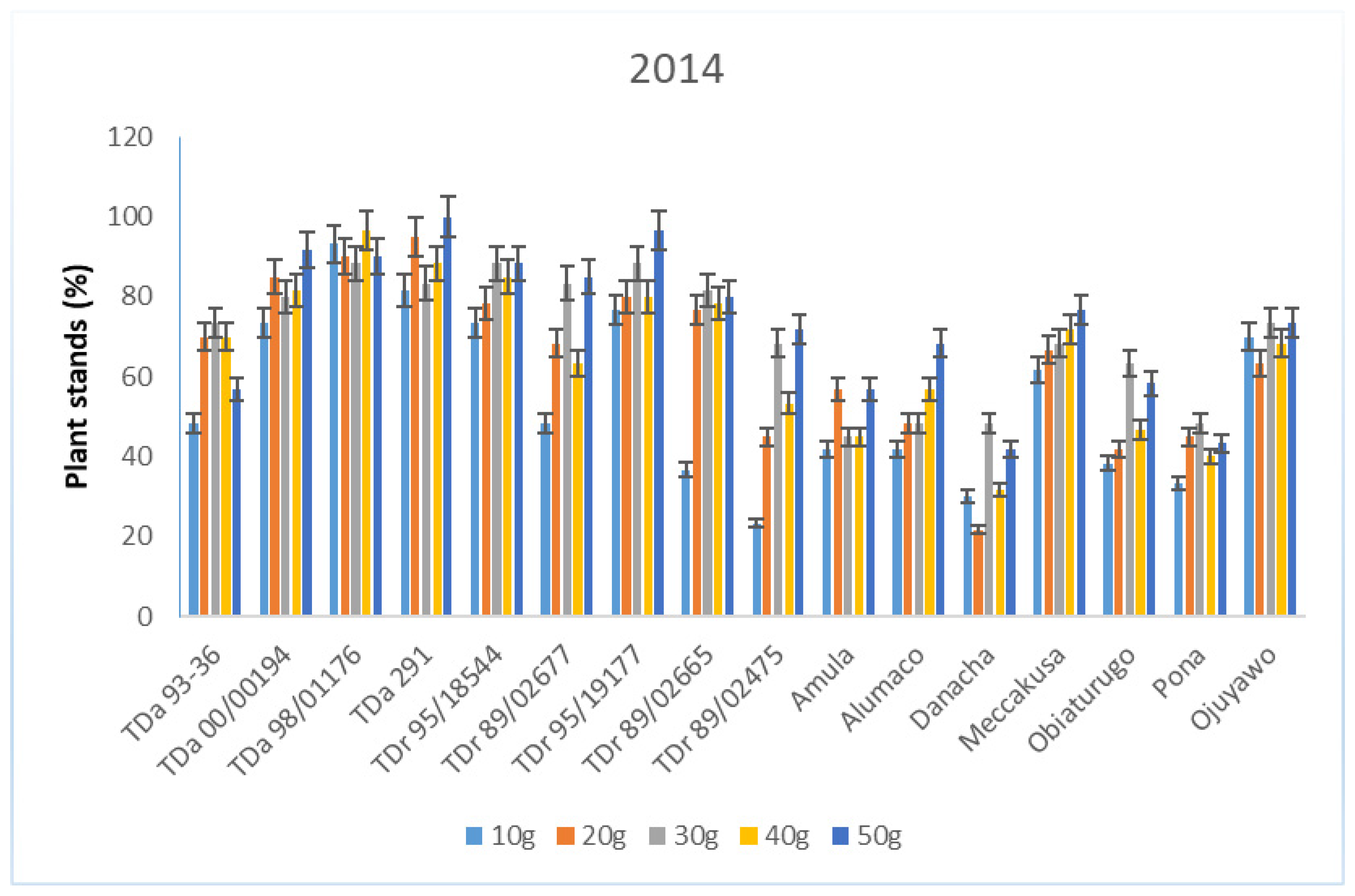
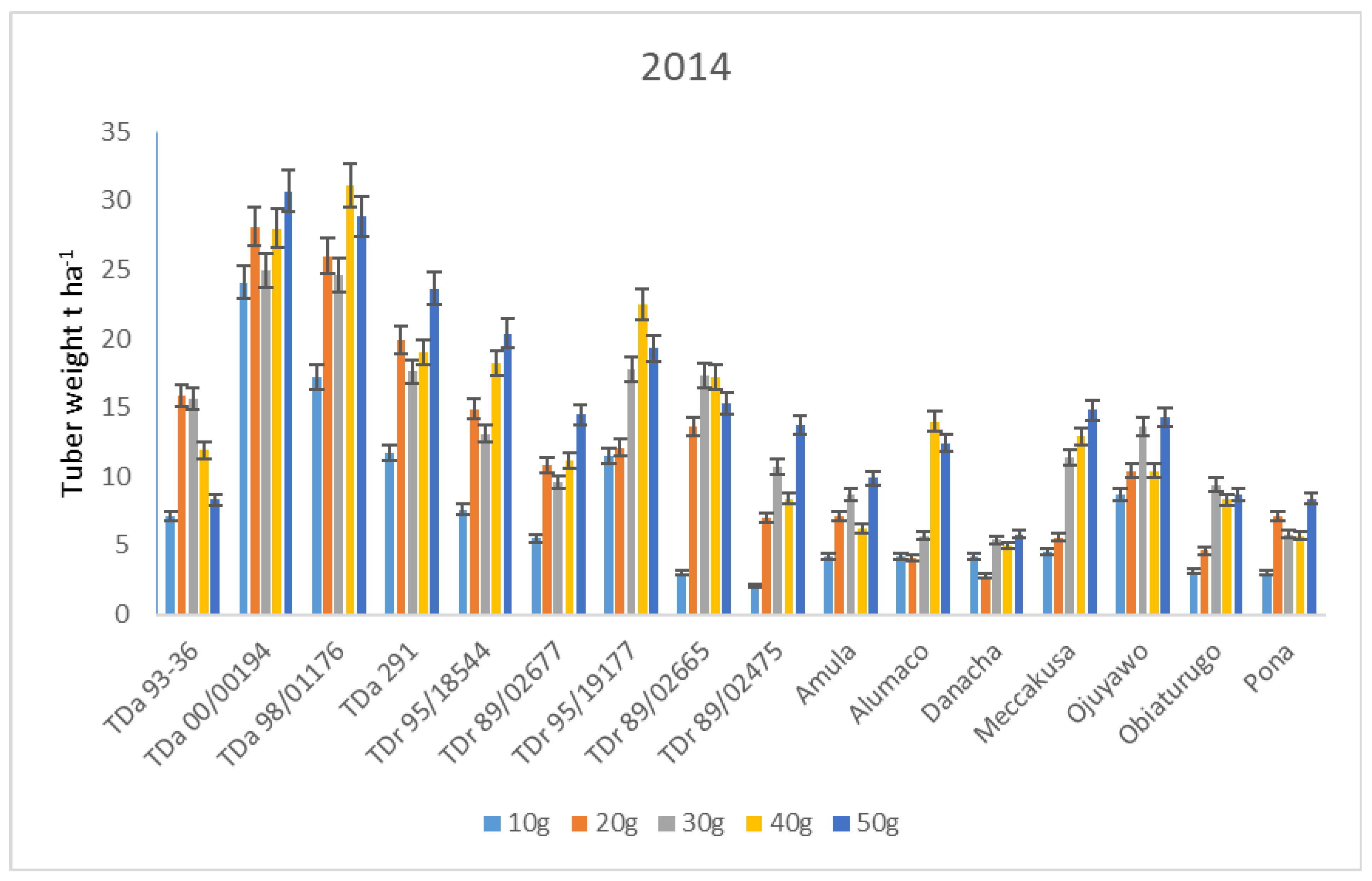
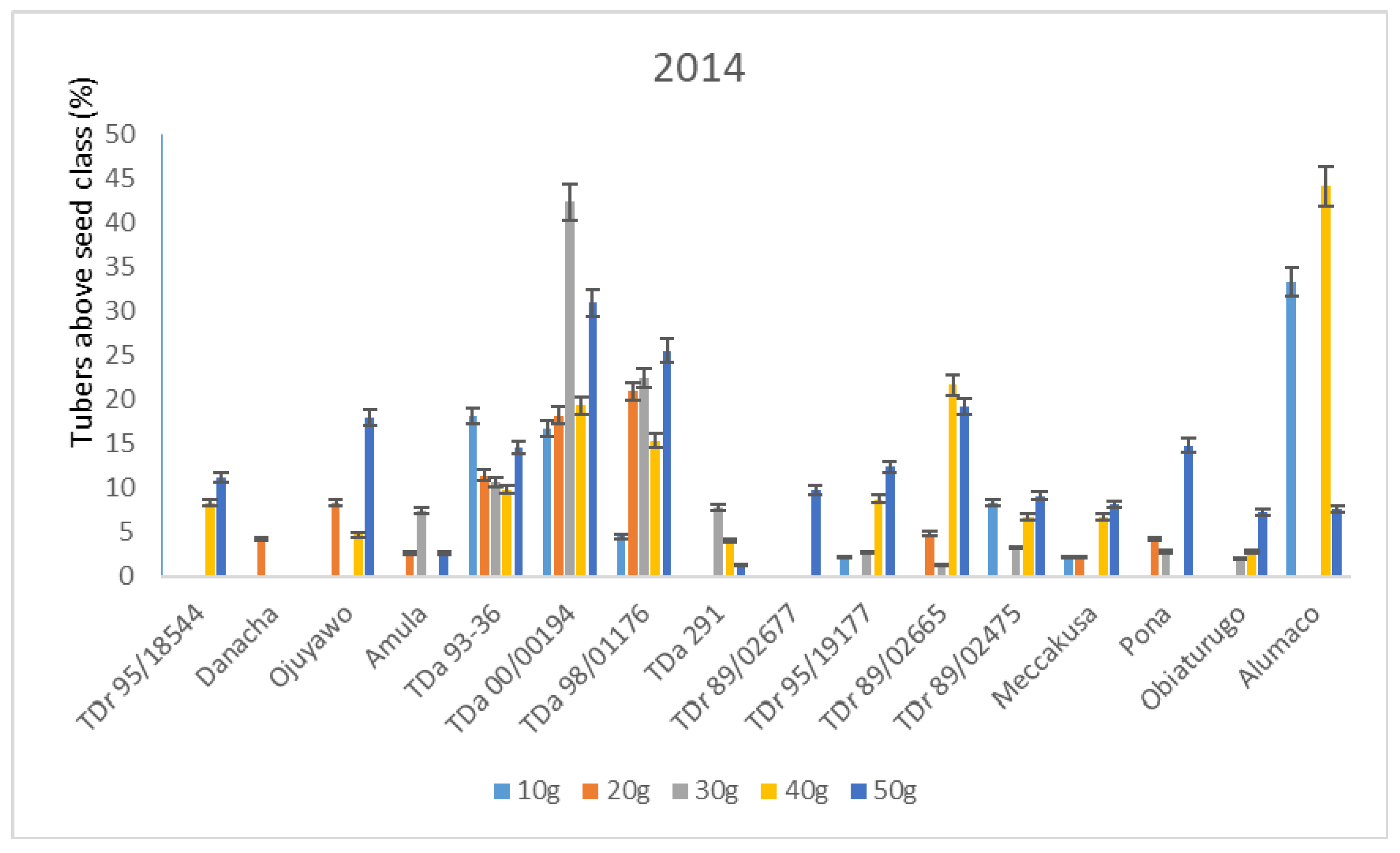
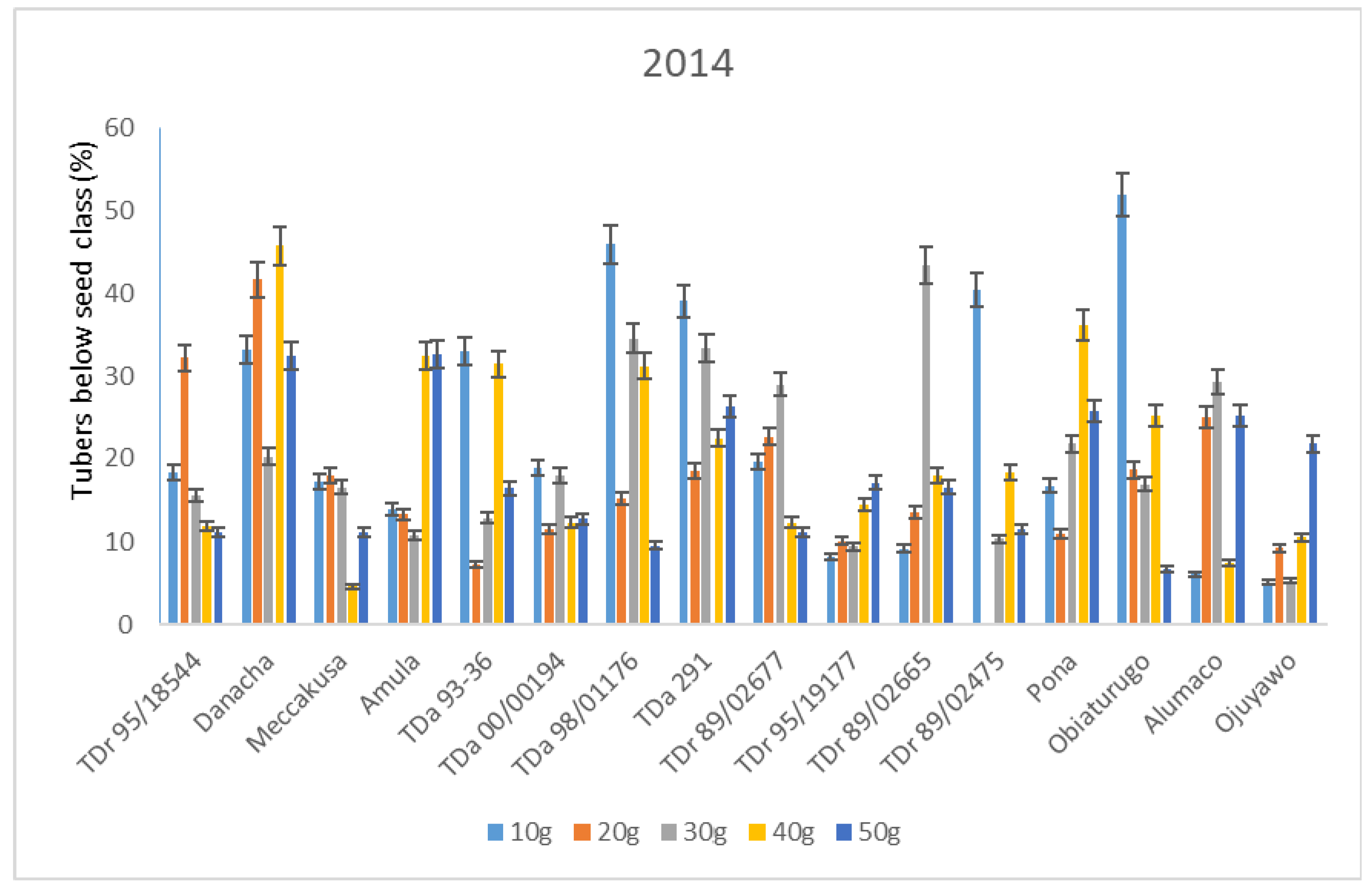
| Varieties | Source | Status | Country of Release/Origin |
|---|---|---|---|
| Dioscorea rotundata | |||
| TDr 95/18544 | YIP–IITA | Improved line | Benin |
| TDr 89/02677 | YIP–IITA | Improved line | Nigeria |
| TDr 95/19177 | YIP–IITA | Improved line | Nigeria |
| TDr 89/02665 | YIP–IITA | Improved line | Nigeria |
| TDr 89/02475 | YIP–IITA | Improved line | Nigeria |
| Ojuyawo | YIP–IITA | Landrace | Nigeria |
| TDr 04–219 (Amula) | YIP–IITA | Landrace | Nigeria |
| Pona | YIP–IITA | Landrace | Ghana |
| Obiaturugo | Ilushi | Landrace | Nigeria |
| Alumaco | YIP–IITA | Landrace | Nigeria |
| Danacha | Ilushi | Landrace | Nigeria |
| Meccakusa | Ilushi | Landrace | Nigeria |
| Dioscorea alata | |||
| TDa 00/00194 | YIP–IITA | Improved line | Nigeria |
| TDa 93–36 | YIP–IITA | Landrace | Nigeria |
| TDa 98/01176 | YIP–IITA | Improved line | Nigeria |
| TDa 291 | YIP–IITA | Landrace | Nigeria |
| Sett Weight (g) | Plant Emergence (%) | Number of Stands Harvested (%) | ||
|---|---|---|---|---|
| 2013 | 2014 | 2013 | 2014 | |
| 10 | 64.5 b | 50.5 b | 57.0 c | 53.7 b |
| 20 | 71.4 ab | 55.0 ab | 65.2 bc | 64.5 ab |
| 30 | 78.5 a | 62.8 a | 75.3 ab | 70.6 a |
| 40 | 82.9 a | 57.5 ab | 81.5 a | 66.0 ab |
| 50 | 79.1 a | 60.3 ab | 80.0 a | 73.6 a |
| LSD (0.05) | 12.8 | 11.1 | 12.5 | 14.2 |
| SE | 4.6 | 4.0 | 4.5 | 5.1 |
| GXSett weight | ns | *** | ns | * |
| Genotype | Plant Emergence (%) | Number of Stands Harvested (%) | ||
|---|---|---|---|---|
| 2013 | 2014 | 2013 | 2014 | |
| Alumaco | 68.3 c | 58.0 d | 75.0 bc | 52.7 c |
| Amula | 49.3 d | 60.0 d | 46.0 cd | 49.0 c |
| Danacha | 28.3 e | 50.7 e | 28.3 e | 34.7 d |
| Ojuyawo | 76.3 bc | 80.7 b | 70.7 bc | 69.7 ab |
| Meccakusa | 62.7 c | 77.3 bc | 56.3 c | 69.0 ab |
| Obiaturugo | 56.3 d | 59.7 d | 52.7 c | 49.7 c |
| Pona | 43.0 d | 42.0 e | 45.7 cd | 42.0 cd |
| TDa 00/00194 | 94.3 a | 94.0 a | 91.0 ab | 82.3 a |
| TDa 291 | 95.0 a | 93.7 a | 96.0 a | 89.7 a |
| TDa 93–36 | 92.3 a | 93.3 a | 83.3 b | 63.7 b |
| TDa 98/01176 | 98.0 a | 95.3 a | 99.0 a | 91.7 a |
| TDr 89/02475 | 93.0 a | 63.3 d | 90.0 ab | 52.3 c |
| TDr 89/02665 | 86.0 ab | 85.7 ab | 80.7 b | 70.7 ab |
| TDr 89/02677 | 87.3 ab | 85.3 ab | 76.7 bc | 69.7 ab |
| TDr 95/18544 | 94.0 a | 91.3 a | 82.7 b | 80.0 a |
| TDr 95/19177 | 80.0 b | 94.0 a | 74.7 bc | 84.33 a |
| LSD (0.05) | 15.2 | 13.1 | 13.2 | 16.2 |
| SE | 5.4 | 4.7 | 4.7 | 5.8 |
| Sett Weight (g) | Number of Tubers/Plot | Tuber Weight t ha−1 | ||
|---|---|---|---|---|
| 2013 | 2014 | 2013 | 2014 | |
| 10 g | 12.9 c | 13.2 b | 9.5 c | 7.6 b |
| 20 g | 15.3 bc | 16.4 ab | 14.7 bc | 11.9 ab |
| 30 g | 17.5 ab | 19.3 ab | 18.4 b | 13.2 a |
| 40 g | 19.7 a | 19.1 ab | 24.2 a | 14.4 a |
| 50 g | 19.0 a | 21.6 a | 25.8 a | 15.6 a |
| LSD (0.05) | 3.0 | 5.3 | 4.9 | 4.9 |
| SE | 1.1 | 1.9 | 1.7 | 1.7 |
| GXSett weight | ns | ns | ns | * |
| Genotypes | Number of Tubers/Plot | Tuber Weight (t ha−1) | ||
|---|---|---|---|---|
| 2013 | 2014 | 2013 | 2014 | |
| Alumaco | 15.6 d | 12.2 cd | 13.3 d | 8.1 c |
| Amula | 10.0 e | 11.8 cd | 6.8 e | 7.2 c |
| Danacha | 6.5 e | 8.2 d | 3.1 e | 4.6 c |
| Ojuyawo | 14.7 d | 15.2 bc | 16.9 d | 11.5 bc |
| Meccakusa | 11.8 de | 14.9 bc | 10.3 de | 9.9 c |
| Obiaturugo | 11.4 de | 11.5 cd | 9.8 de | 6.8 c |
| Pona | 9.3 e | 8.9 d | 9.0 de | 6.0 c |
| TDa 00/00194 | 20.4 c | 23.0 b | 39.9 a | 27.2 a |
| TDa 291 | 26.3 b | 35.1 a | 28.3 b | 18.3 b |
| TDa 93-36 | 17.4 cd | 14.3 cd | 30.9 b | 11.8 bc |
| TDa 98/01176 | 31.1 a | 32.3 a | 36.6 ab | 25.6 a |
| TDr 89/02475 | 20.9 c | 12.2 cd | 20.6 cd | 8.4 c |
| TDr 89/02665 | 18.1 cd | 19.8 bc | 17.3 d | 13.3 bc |
| TDr 89/02677 | 19.6 c | 19.3 bc | 14.2 d | 10.3 c |
| TDr 95/18544 | 20.9 c | 25.4 b | 17.6 d | 14.9 bc |
| TDr 95/19177 | 16.4 cd | 22.5 b | 21.2 c | 16.6 bc |
| LSD (0.05) | 4.5 | 6.9 | 8.4 | 5.9 |
| SE | 1.6 | 2.4 | 3.0 | 2.1 |
| Sett Weight (g) | Seed Tubers Harvested (%) | Proportion of Seed Tubers Heavier Than Seed Category (%) | Proportion of Seed Tubers Lighter Than Seed Category (%) | |||
|---|---|---|---|---|---|---|
| 2013 | 2014 | 2013 | 2014 | 2013 | 2014 | |
| 10 g | 56.4 a | 58.0 b | 26.1 b | 5.3 b | 17.5 a | 36.7 c |
| 20 g | 56.1 a | 55.6 c | 33.3 b | 5.5 b | 10.7 b | 38.9 bc |
| 30 g | 55.5 a | 60.5 a | 38.3 ab | 6.4 b | 6.3 bc | 33.1 d |
| 40 g | 44.5 ab | 46.4 d | 50.5 a | 9.4 ab | 4.9 c | 44.2 a |
| 50 g | 40.2 b | 48.4 d | 57.6 a | 12.0 a | 2.2 c | 39.6 b |
| LSD (0.05) | 14.2 | 2.3 | 12.4 | 4.6 | 5.7 | 2.6 |
| SE | 5.0 | 0.8 | 4.4 | 1.6 | 2.0 | 1.0 |
| GXSett weight | ns | ns | ns | * | ns | * |
| Genotypes | Seed Tubers Harvested (%) | Proportion of Seed Tubers Heavier Than Seed Category (%) | Proportion of Seed Tubers Lighter Than Seed Category (%) | |||
|---|---|---|---|---|---|---|
| 2013 | 2014 | 2013 | 2014 | 2013 | 2014 | |
| Alumaco | 68.8 a | 64.3 ab | 22.4 bc | 17.0 ab | 8.8 bc | 18.7 ab |
| Amula | 72.2 a | 76.8 a | 15.6 c | 2.5 b | 12.2 b | 20.7 ab |
| Danacha | 56.3 b | 64.4 ab | 8.2 c | 0.8 b | 35.5 a | 34.7 a |
| Ojuyawo | 68.2 a | 83.5 a | 28.4 b | 6.2 b | 3.5 c | 10.4 b |
| Meccakusa | 65.5 a | 83.0 a | 21.7 bc | 3.5 b | 12.8 b | 13.5 b |
| Obiaturugo | 71.6 a | 73.7 a | 19.1 c | 2.4 b | 9.3 bc | 23.9 ab |
| Pona | 61.6 ab | 73.3 a | 27.1 b | 4.4 b | 11.4 bc | 22.3 ab |
| TDa 00/00194 | 8.2 c | 59.9 ab | 91.9 a | 25.5 a | 0.0 c | 14.7 ab |
| TDa 291 | 12.8 c | 69.4 ab | 86.5 a | 2.6 b | 0.7 c | 28.0 ab |
| TDa 93-36 | 10.5 c | 66.9 ab | 89.0 a | 12.9 ab | 0.5 c | 20.3 ab |
| TDa 98/01176 | 12.6 c | 55.0 b | 87.4 a | 17.7 ab | 0.0 c | 27.3 ab |
| TDr 89/02475 | 62.6 ab | 78.4 a | 32.0 b | 5.5 b | 5.4 bc | 16.1 ab |
| TDr 89/02665 | 64.8 ab | 70.5 ab | 27.8 b | 9.4 b | 7.3 bc | 20.1 ab |
| TDr 89/02677 | 63.3 ab | 79.1 a | 30.6 b | 1.9 b | 6.1 bc | 19.0 ab |
| TDr 95/18544 | 59.2 ab | 75.9 ab | 32.4 b | 6.2 b | 8.4 bc | 17.9 ab |
| TDr 95/19177 | 50.4 b | 82.9 a | 38.6 b | 5.2 b | 11.0 bc | 11.9 b |
| LSD (0.05) | 22.0 | 23.0 | 17.8 | 14.5 | 11.9 | 20.4 |
| SE | 7.9 | 8.2 | 6.4 | 5.2 | 4.3 | 7.3 |
| Plant Emergence (%) | Number of Plant Stands at Harvest (%) | NOT @ Harvest | Tuber Weight (t ha−1) | STH (%) | STHHTSC (%) | STHLTSC (%) | |
|---|---|---|---|---|---|---|---|
| Plant emergence (%) | 1.00 | ||||||
| Number of plant stands at harvest (%) | 1.00 * | 1.00 | |||||
| NOT @ harvest | 1.00 ** | 0.94 ** | 1.00 | ||||
| Tuber weight t ha−1 | 0.81 | 0.94 ** | 0.81 | 1.00 | |||
| STH (%) | −0.63 | −0.7 | −0.6 | −0.94 ** | 1.00 | ||
| STHHTSC (%) | 0.74 | 0.73 | 0.73 | 0.90 ** | −1.00 ** | 1.00 | |
| STHLTSC (%) | −0.81 ** | −0.81 ** | −0.73 | −0.81 | 0.53 | −0.73 | 1.00 |
| Plant Emergence (%) | Number of Plant Stands at Harvest (%) | NOT @ Harvest | Yield (t ha−1) | STH (%) | STHHTSC (%) | STHLTSC (%) | |
|---|---|---|---|---|---|---|---|
| Plant emergence (%) | 1.00 | ||||||
| Number of plant stands at harvest (%) | 0.92 ** | 1.00 | |||||
| NOT @ harvest | 0.83 | 0.92 ** | 1.00 | ||||
| Tuber weight t ha−1 | 0.83 | 0.92 ** | 0.82 ** | 1.00 | |||
| STH (%) | −0.13 | −0.11 | −0.33 | −0.54 | 1.00 | ||
| STHHTSC (%) | 0.40 | 0.40 | 0.33 | 0.70 | −0.70 | 1.00 | |
| STHLTSC (%) | −0.34 | −0.34 | 0.11 | −0.11 | −0.6 | −0.23 | 1.00 |
Disclaimer/Publisher’s Note: The statements, opinions and data contained in all publications are solely those of the individual author(s) and contributor(s) and not of MDPI and/or the editor(s). MDPI and/or the editor(s) disclaim responsibility for any injury to people or property resulting from any ideas, methods, instructions or products referred to in the content. |
© 2025 by the authors. Licensee MDPI, Basel, Switzerland. This article is an open access article distributed under the terms and conditions of the Creative Commons Attribution (CC BY) license (https://creativecommons.org/licenses/by/4.0/).
Share and Cite
Pelemo, O.S.; Okolie, O.C.; Olaniyan, A.B.; Agre, P.; Balogun, M.; Maroya, N.; Akoroda, M.; Asiedu, R. Effects of Variety and Sett Weights on Sprout Emergence and Seed Tuber Yield in Dioscorea alata L. and Dioscorea rotundata Poir. Crops 2025, 5, 38. https://doi.org/10.3390/crops5030038
Pelemo OS, Okolie OC, Olaniyan AB, Agre P, Balogun M, Maroya N, Akoroda M, Asiedu R. Effects of Variety and Sett Weights on Sprout Emergence and Seed Tuber Yield in Dioscorea alata L. and Dioscorea rotundata Poir. Crops. 2025; 5(3):38. https://doi.org/10.3390/crops5030038
Chicago/Turabian StylePelemo, Olugboyega Success, Ossai Chukwunalu Okolie, Amudalat Bolanle Olaniyan, Paterne Agre, Morufat Balogun, Norbert Maroya, Malachy Akoroda, and Robert Asiedu. 2025. "Effects of Variety and Sett Weights on Sprout Emergence and Seed Tuber Yield in Dioscorea alata L. and Dioscorea rotundata Poir." Crops 5, no. 3: 38. https://doi.org/10.3390/crops5030038
APA StylePelemo, O. S., Okolie, O. C., Olaniyan, A. B., Agre, P., Balogun, M., Maroya, N., Akoroda, M., & Asiedu, R. (2025). Effects of Variety and Sett Weights on Sprout Emergence and Seed Tuber Yield in Dioscorea alata L. and Dioscorea rotundata Poir. Crops, 5(3), 38. https://doi.org/10.3390/crops5030038







